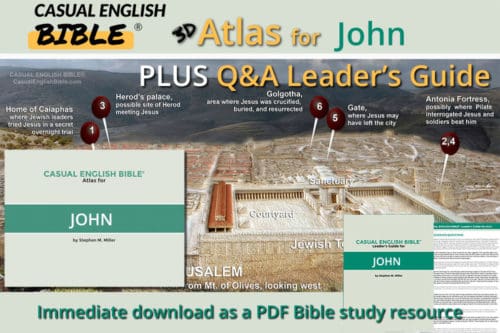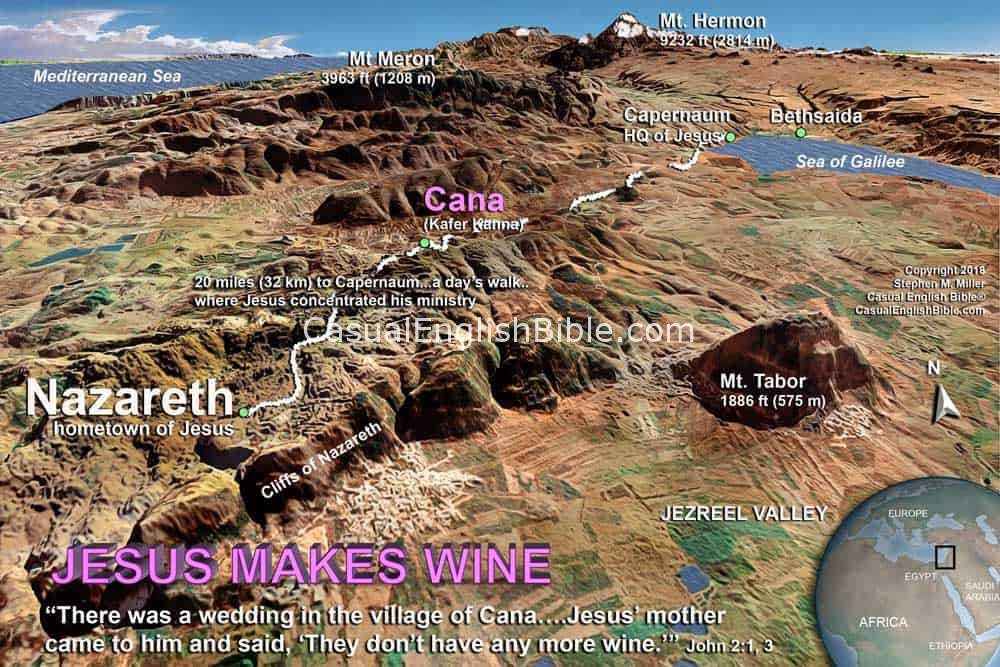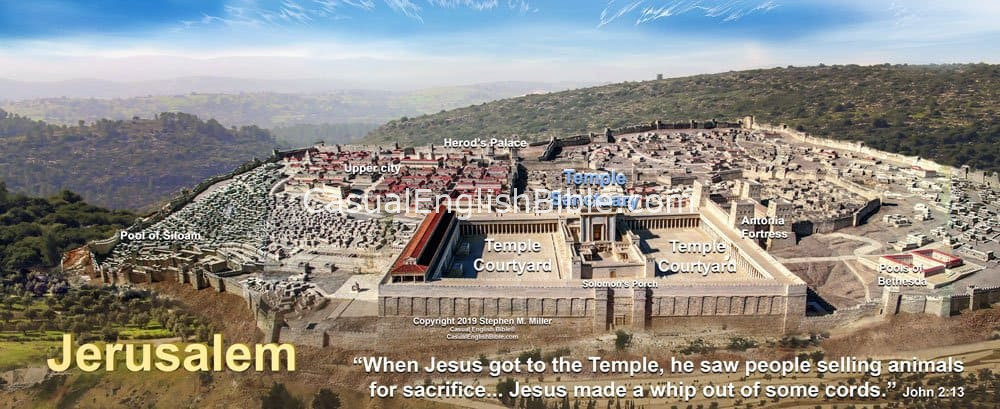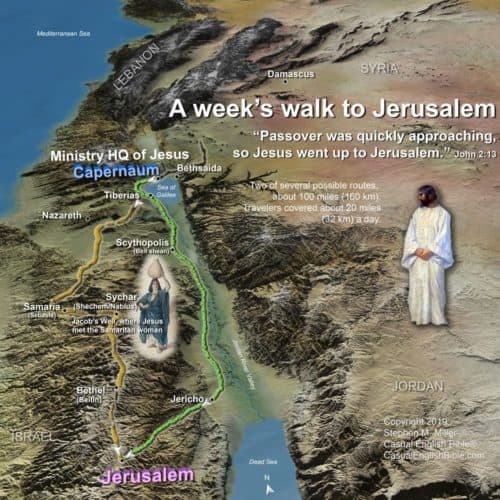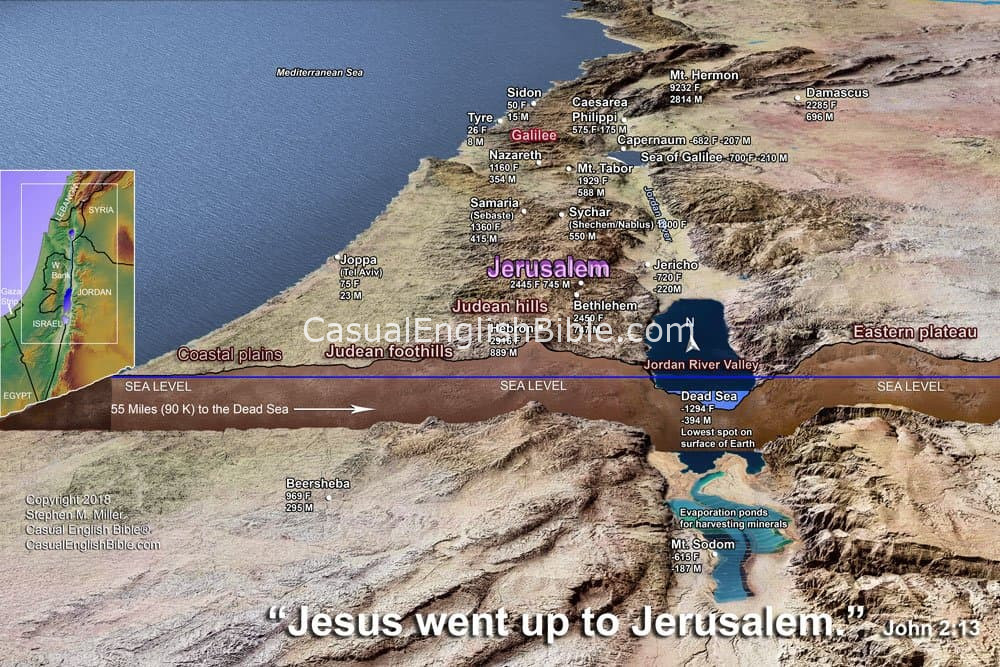John 2
Jesus starts the clock on his ministry
Jesus Makes Water into Wine at Cana
1There was a wedding in the village of Cana in Galilee two days later. [1] Jesus’s mother was there. [2] 2Jesus and his disciples were also invited. 3The wedding party ran out of wine. Jesus’s mother came to him and said, “They don’t have any more wine.”4Jesus said, “Dear woman, [3] what does that have to do with us? It’s not time for me to start.” [4]
5Regardless, his mother told the servers, “Do exactly what he tells you.” [5]
6There were six stone water jars nearby, each able to hold some 20 to 30 gallons. [6] Jews used the water to wash themselves in cleansing rituals. 7Jesus told the wedding servers, “Fill the jars with water.” So they did it. They filled the jars to the brim. 8Then he told them, “Now dip some out and take it to the wedding coordinator.” So, they did it. They took him some wine to sample.
9When the man coordinating the celebration got a taste of the water that became wine, he called out to the groom. The coordinator didn’t know where the wine came from, but the servers certainly did. 10The wedding coordinator told the groom, “Everyone serves the best wine first. Then when guests are starting to feel the buzz, they get the cheaper wine. But look at you. You saved the best wine for now. Cheers.”
11This was the first signpost miracle [7] Jesus did. Cana of Galilee is where he first revealed his glorifying power. His disciples became believers. [8]
12After the wedding, Jesus left Cana and went down to Capernaum. His disciples came too. So did his mother and his brothers. They stayed just a few days.
Jesus Cleans House at the Temple
13Passover [9] was quickly approaching, so Jesus went up to Jerusalem. [10] 14When Jesus got to the Temple, he saw people selling animals for sacrifice: cattle, sheep, and doves. [11] Bankers had set up currency exchange services there too. [12] 15Jesus made a whip out of some cords. He managed to drive away all the business people along with the livestock: sheep and cattle. Money went flying as Jesus flipped the tables of the bankers. 16When he got to the people selling doves, he told them, “Get them out of here! My Father’s house isn’t a bird store!” [13]17The disciples remembered something they had been taught from their Bible:
“My passionate devotion to your house will get me killed.” [14]
18Some of the Jews there said, “Hey, what do you think you’re doing? Let’s see some proof that you have the authority to do this.”
19Jesus answered, “You want proof? Destroy this Temple and I’ll raise it back up in three days!”
20The Jews said, “This Temple has been under construction for the past 46 years. And you’re telling us you could rebuild it in three days?” 21But Jesus was talking about his body as a temple.
22Later, after he rose from the dead, his disciples remembered what he had said. They remembered the Bible passage he had quoted too. They believed those words of the Bible and what Jesus said about it. [15]
Miracles Go Public
23While Jesus celebrated the religious holiday of Passover in Jerusalem, a lot of people saw him perform miracles—proof of his power. Many folks believed in him because of it. 24Though they trusted him, he didn’t trust them. He knew what people are like. 25He didn’t need any character witnesses for humanity. He knew humans inside and out.Footnotes
John simply says the wedding was “on the third day” (New American Standard Bible). Scholars have to guess what he meant by that. One guess is that it’s the third day after the last event John reported: Jesus’s meeting Nathaniel, in John 1. If that meeting was day one, then the wedding was two days later, “on the third day.” Some scholars say that John used that odd phrasing to hint about the Resurrection, which also took place on the third day.
Mary may have been more than a guest. Since she insisted that Jesus make miracle wine for the wedding, some scholars say she may have been helping with the celebration.
Jesus addresses Mary as “Woman,” which doesn’t sound especially endearing. But it’s all in the delivery. He uses the same word when he talks to Mary from the cross (John 19:26), entrusting her care to one of the disciples—John, according to ancient Christian writings.
A more literal translation is “My hour has not yet come.” John uses “hour” throughout his Gospel to refer to key events in Jesus’s life and ministry: arrest (John 7:30); glory of the Resurrection (John 12:23). Jesus doesn’t want to be rushed into launching his ministry of teaching and performing miracles.
When Mary tells the servants to do what Jesus says, she’s also kinda telling Jesus to do what she says. Mothers.
75 to 115 liters.
John reports only seven miracles of Jesus. He calls each one a “sign” because each one provides evidence that Jesus is the divine Son of God. The seven signs:
1. Water into wine (2:1-11)
2. Healing son of government official (4:46-54)
3. Healing paralyzed man (5:1-15)
4. Feeding 5,000 (6:5-14)
5. Walking on water (6:16-24)
6. Healing blind man (9:1-7)
7. Raising Lazarus from the dead (11:1-45)
John has reported that Jesus’s first disciples were believers. Nathanael, for one (John 1:49). If the others hadn’t been full-fledged believers before Jesus turned the water into wine, they were afterward. They probably saw the miracle. Likely, they drank the proof.
Jews call this holiday by its Hebrew name: Pesach (PAY-sah). It was also called the Festival of Unleavened Bread. This bread was flatbread made with no yeast. Yeast is what makes bread dough rise. Many Jews today celebrate the holiday by eating cracker-like matzo. Tortillas would also qualify. The festival is a seven-day celebration beginning on the 14th day of the first month in the Jewish new year: Nisan, usually sometime in March or April. It varies because the Jewish calendar is based on the cycles of the moon. Jewish pilgrims came from all over the world to celebrate Passover in Jerusalem, somewhat like Christian pilgrims today go to Bethlehem at Christmas and Jerusalem at Easter. One difference is that the pilgrimage is optional for Christians, but the law of Moses ordered it for Jews. At Passover, Jerusalem swelled to many times its normal size.
Jerusalem was south of Capernaum. But Bible writers usually described Jerusalem as “up” from everywhere because it sat on the ridge of a hill. People had to climb to get to Jerusalem. There was also, perhaps, a sense of reverence in the description of going up to what became known as the Holy City. In the other three Gospels, the story of Jesus chasing the merchants out of the Temple shows up in the final days of Jesus’s ministry (Matthew 21:10-17; Mark 11:15-19; Luke 19:45-46).
Vendors may have rented space to sell their products in the sprawling Temple courtyards. Temple priests may have profited from this by accepting part of the rent money or perhaps a percentage of the sales. People headed to the Temple to offer animal sacrifices may have appreciated the quick-stop shop for animals that may have been preapproved for sacrifices. There were rules about which animals could and could not be offered to God in sacrifice. It was only the best livestock; “no defects” (Leviticus 1:3, New Living Translation).
The Temple accepted only selected currency, which did not have engraved images of people or animals. “Money changers,” as they are sometimes called, performed much the same service as banks when people from one nation visit another and need to use a different type of currency. Some Jews may have considered it a convenience to have the currency exchange service right there on the Temple property.
Jesus calls it an emporion, the Greek word from which we get emporium, a large retail center or a superstore. What he does sounds a bit like something one of the prophets predicted: “At that time there will not be any buyers or sellers in the Temple of the LORD All-Powerful” (Zechariah 14:21, New Century Version).
Psalm 69:9
Possibly a reference to Psalm 69:9, about how Jesus’s devotion to the Temple would be the death of him.
Discussion Questions
- 1
Okay, as Jesus’s first reported miracle on earth, why would he turn water into enough wine to get perhaps a thousand people too drunk to drive a donkey cart? He made about 120 gallons (454 liters). That’s around 600 to 700 bottles of wine. Cheers.
- 2
Why do you think Jesus didn’t want to perform the miracle of turning water into wine? He gave in to his mother’s request only after she persisted, as mothers sometimes do.
- 3
Turning water into wine is the first of only seven miracles John reports from the ministry of Jesus. John calls each one of these miracles “signs” because each one provides evidence that Jesus is the divine Son of God. What evidence do you see in each of these miracles?
- Water into wine (2:1-11)
- Healing son of government official (4:46-54)
- Healing paralyzed man (5:1-15)
- Feeding 5,000 (6:5-14)
- Walking on water (6:16-24)
- Healing blind man (9:1-7)
- Raising Lazarus from the dead (11:1-45)
- 4
When Jesus started teaching in the Temple, and then cleared the area of merchants making a shekel, some of the Jewish leaders asked him for his credentials: “Hey, what do you think you’re doing? Let’s see some proof that you have the authority to do this” (John 2:18). He wasn’t a fresh face with a hopeful message. He was a threat. Why do you think they saw him as a threat even before he flipped tables? John puts this table-flipping story at the beginning of Jesus’s ministry, but the other gospel writers put it during the last week of his life.
- 5
When Jesus answered the question Jewish leaders raised about why he felt he had the right to chase merchants out of the Temple area, Jesus didn’t give them a straight answer. He said, “You want proof? Destroy this Temple and I’ll raise it back up in three days!” (John 2:19). John says Jesus was talking about his body, not the Jerusalem Temple. So why didn’t Jesus just say, “You want proof? I’ll show you proof. Kill me on Friday and I’ll come back to see you on Sunday morning”?
- 6
It’s an odd end to this chapter: “Many folks believed in him because of it [his miracles]. Though they trusted him, he didn’t trust them. He knew what people are like. He didn’t need any character witnesses for humanity. He knew humans inside and out” (John 2:23-25). What you think Jesus knew about people that made him not trust the support he was getting?
- 7
LIFE APPLICATION. When Christians want to justify an angry outburst, they often talk about Jesus getting angry in the Temple and chasing away the merchants who were selling products in the Temple courtyard (John 2:13-15). What do you think about that? Is it a fair comparison?



